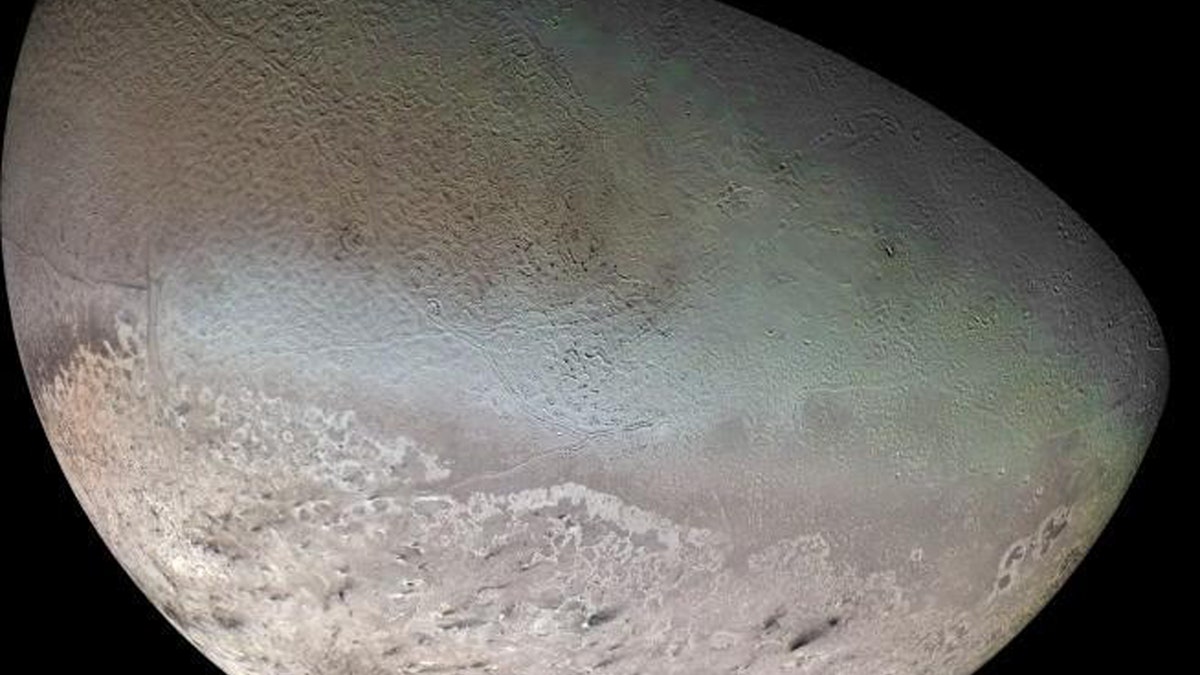
Global color mosaic of Triton, taken in 1989 by Voyager 2 during its flyby of the Neptune system. (Credit: NASA/JPL/USGS)
NASA is planning a mission to the coldest known object in our solar system in its hunt for alien life.
The legendary space agency wants to send a high tech probe to Neptune's icy moon Triton, which some believe holds an ocean hidden under its surface.
Water is one of the key ingredients for life, meaning if Triton has an ocean it could harbor tiny extraterrestrial microbes.
Scientists from Nasa's Jet Propulsion Laboratory put forward plans to explore the moon at the Lunar and Planetary Science Conference in Texas.
The mission would involve developing a new kind of spacecraft known as Trident.
It would fly to Triton and take photographs of the icy object, while also studying its atmosphere and chemical makeup for signs of an underground ocean.
If water is found, then NASA would mark Triton – the largest of Neptune's 13 moons – as a key target for future alien hunting missions.
Trident would also give scientists a chance to visit Neptune and its moons for the first time since the 1980s, as well as explore an object from the Kuiper belt.
The belt is a ring of icy lumps that sits well beyond Neptune, and scientists believe Triton is a Kuiper object that got knocked into Neptune's gravitational pull billion of years ago.
"Triton shows tantalizing hints at being active and having an ocean," NASA scientist Dr. Amanda Hendrix told the New York Times.
"It is a three-for-one target, because you can visit the Neptune system, visit this interesting ocean world, and also visit a Kuiper belt object without having to go all the way out there."
Little is known about Triton, and the only images we have of the moon were captured by the Voyager 2 probe in 1989.
During that flyby, space boffins spotted geysers on Triton that spewed out nitrogen gas. Nasa earmarked it for further research.
The moon is thought to be similar to Pluto in many ways, and is the coldest known object in the solar system, with surface temperatures plummeting to a frigid -235°C.
That makes it two and a half times colder than the coolest temperature ever recorded on Earth – a frosty -89.2°C logged at a Soviet weather station in Antarctica in 1983.
The proposed mission to Triton hinges on its price tag.
Launching Trident would cost less than $500 million £380 million – about the same as a small mission to the Moon.
That could make the difference as the team push for funding from NASA's highly competitive Discovery program.
NASA's goal is to deploy these missions once every two years, and Trident is up against three other potential missions for the next free slot.
They include trip's Earth's moon, as well as Jupiter's moon Io and a return to Venus.
According to Louise Prockter, chief investigator for Trident, now is the time to launch a Triton mission as it's vital to find out if the moon hosts alien life.
Dr. Hendrix added that objects like Triton could help us gain fresh insights into how ocean worlds form and hold water.
For example, Triton's temperatures are way below freezing, but could contain ammonia that keeps its ocean in a liquid form.
Clues like this could help us find and explore other ocean worlds in future as we explore whether or not we're alone in the universe.
This story originally appeared in The Sun.



















